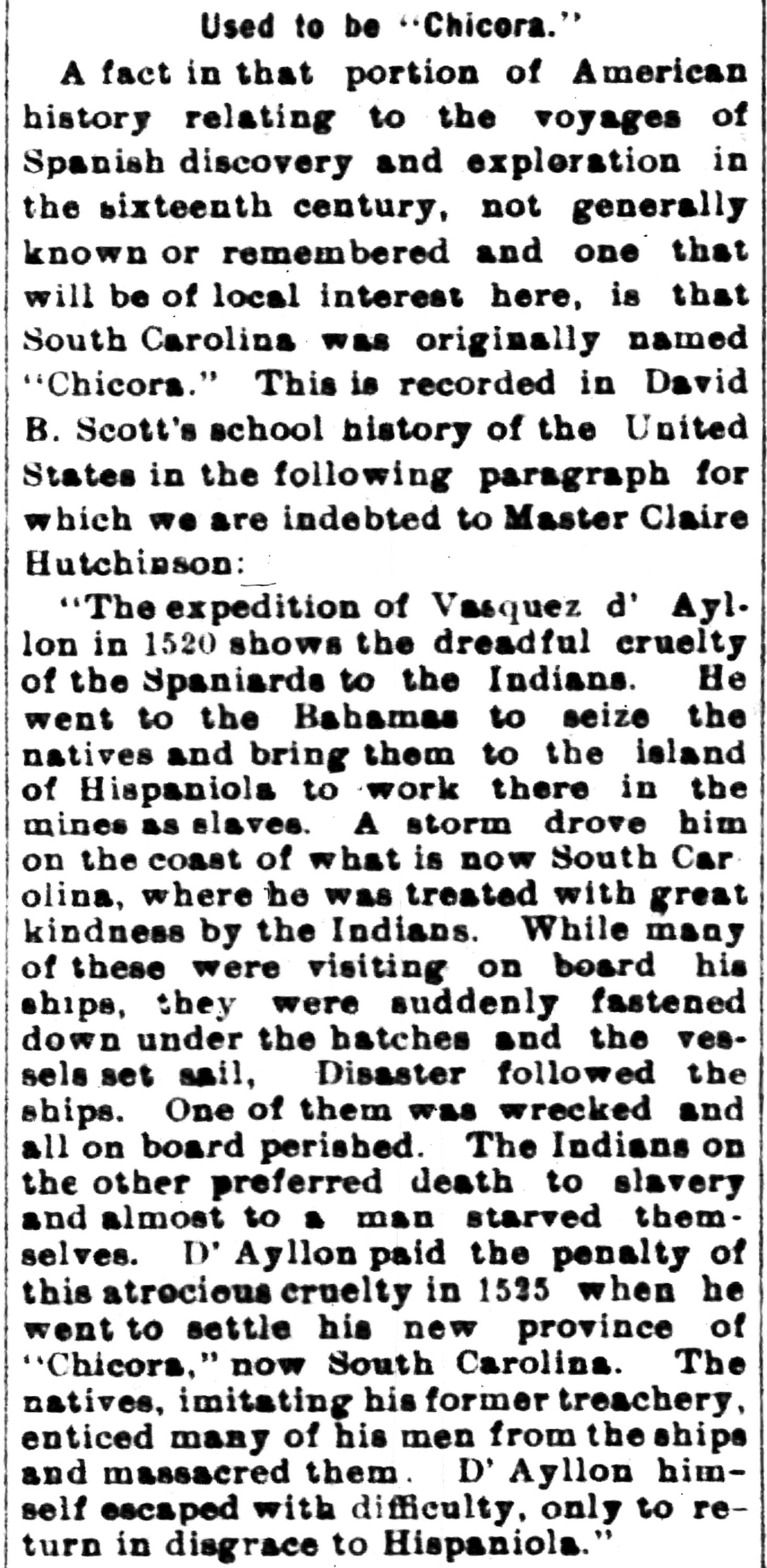Chicora tribe on:
[Wikipedia]
[Google]
[Amazon]
 Chicora was a legendary Native American kingdom or tribe sought during the 16th century by various European explorers in present-day
Chicora was a legendary Native American kingdom or tribe sought during the 16th century by various European explorers in present-day
 Chicora was a legendary Native American kingdom or tribe sought during the 16th century by various European explorers in present-day
Chicora was a legendary Native American kingdom or tribe sought during the 16th century by various European explorers in present-day South Carolina
)'' Animis opibusque parati'' ( for, , Latin, Prepared in mind and resources, links=no)
, anthem = " Carolina";" South Carolina On My Mind"
, Former = Province of South Carolina
, seat = Columbia
, LargestCity = Charleston
, LargestMetro = ...
. The legend originated after Spanish slave traders captured an Indian they called Francisco de Chicora Francisco de Chicora was the baptismal name given to a Native American kidnapped in 1521, along with 70 others, from near Winyah Bay by Spanish explorer Francisco Gordillo and slave trader Pedro de Quexos, based in Santo Domingo and the first Europ ...
in 1521; afterward, they came to treat Francisco's home country as a land of abundant wealth and natural resources. The "Chicora Legend" influenced both the Spanish and the French in their attempts to colonize North America for the next 60 years.
History
In 1521, Spanish slavers Pedro de Quexo and Francisco Gordillo embarked on an expedition from the Caribbean to the little-explored mainland of what is now theSoutheastern United States
The Southeastern United States, also referred to as the American Southeast or simply the Southeast, is a geographical region of the United States. It is located broadly on the eastern portion of the southern United States and the southern por ...
. On June 24, they sighted what is thought to be the area around the mouth of the Santee River
}
The Santee River is a river in South Carolina in the United States, and is long. The Santee and its tributaries provide the principal drainage for the coastal areas of southeastern South Carolina and navigation for the central coastal plain of ...
; they named their discovery the Land of St. John the Baptist. For the next 22 days they explored the river and nearby Winyah Bay
The Winyaw were a Native American tribe living near Winyah Bay, Black River, and the lower course of the Pee Dee River in South Carolina. The Winyaw people disappeared as a distinct entity after 1720 and are thought to have merged with the Wacc ...
and made contact with the locals, including, they claimed, a town or people called Chicora. Ultimately, the slavers compelled around 60 Indians to board their ships and then sailed off without warning, intending to sell the captives into slavery in Hispaniola. Among the captives was an Indian who the Spanish eventually named Francisco de Chicora Francisco de Chicora was the baptismal name given to a Native American kidnapped in 1521, along with 70 others, from near Winyah Bay by Spanish explorer Francisco Gordillo and slave trader Pedro de Quexos, based in Santo Domingo and the first Europ ...
.
Upon their return, Gordillo's backer Lucas Vázquez de Ayllón
Lucas Vázquez de Ayllón (c. 1480 – 18 October 1526) was a Spanish magistrate and explorer who in 1526 established the short-lived San Miguel de Gualdape colony, one of the first European attempts at a settlement in what is now the United State ...
petitioned the Spanish Real Audiencia
A ''Real Audiencia'' (), or simply an ''Audiencia'' ( ca, Reial Audiència, Audiència Reial, or Audiència), was an appellate court in Spain and its empire. The name of the institution literally translates as Royal Audience. The additional des ...
for the right to conquer and settle the land. The next year he took his case to the crown in Spain, promoting his claim with evidently exaggerated tales about the bounty that awaited in Chicora. By this time Francisco de Chicora (or Francisco Chicorano) had been baptized and learned Spanish, and started working as Ayllón's personal servant. He joined Ayllón in Spain, and contributed to his master's accounts of the wealth of his homeland. Ayllón moved the coordinates of the land from the 33.5 degrees north recorded by Gordillo to 35–37 degrees. Evidently, this was an effort to sell Chicora as a "new Andalusia
Andalusia (, ; es, Andalucía ) is the southernmost autonomous community in Peninsular Spain. It is the most populous and the second-largest autonomous community in the country. It is officially recognised as a "historical nationality". The t ...
" by giving it parallel coordinates to the famously fertile area of Spain. The Crown granted Ayllón's request. Peter Martyr d'Anghiera also met with Ayllón and Francisco and recorded notes about "Chicora", which spread awareness of the territory, particularly after they were published in Martyr's chronicle ''Decade'' in 1530.
See also
*Francisco de Chicora Francisco de Chicora was the baptismal name given to a Native American kidnapped in 1521, along with 70 others, from near Winyah Bay by Spanish explorer Francisco Gordillo and slave trader Pedro de Quexos, based in Santo Domingo and the first Europ ...
*Cape Fear Indians
The Cape Fear Indians were a small, coastal tribe of Native Americans who lived on the Cape Fear River in North Carolina (now Carolina Beach State Park).
Name and language
The autonym of the Cape Fear Indians may have been Daw-hee. Their name f ...
*Waccamaw
The Waccamaw people were an Indigenous people of the Southeastern Woodlands, who lived in villages along the Waccamaw and Pee Dee rivers in North and South Carolina in the 18th century.Lerch 328
Language
Very little remains of the Waccam ...
Notes
References
* {{DEFAULTSORT:Chicora French colonization of the Americas Mythological kingdoms, empires, and countries Native American tribes in South Carolina Spanish colonization of the Americas